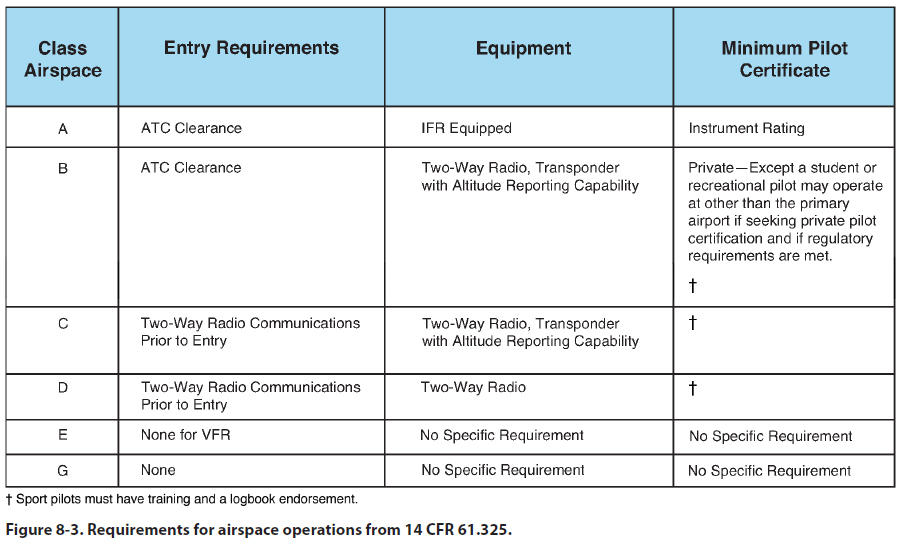Chapter 8 — Airspace Classification and Requirements
Published VFR Routes
Published VFR routes are for transitioning around,
under, or through some complex airspace. Terms such
as VFR flyway, VFR corridor, Class B airspace, VFR
transition route, and terminal area VFR route have
been applied to such routes. These routes are generally
found on VFR terminal area planning charts.
Terminal Radar Service Areas
Terminal Radar Service Areas (TRSA) are areas
where participating pilots can receive additional radar
services. The purpose of the service is to provide
separation between all IFR operations and participating
VFR aircraft.
The primary airport(s) within the TRSA become(s)
Class D airspace. The remaining portion of the TRSA
overlies other controlled airspace, which is normally
Class E airspace beginning at 700 or 1,200 feet and
established to transition to/from the en route terminal
environment. TRSAs are depicted on VFR sectional
charts and terminal area charts with a solid black line
and altitudes for each segment. The Class D portion is
charted with a blue segmented line.
Participation in TRSA services is voluntary; however,
pilots operating under VFR are encouraged to contact
the radar approach control and take advantage of
TRSA service.
National Security Areas
National security areas consist of airspace of defined
vertical and lateral dimensions established at locations
where there is a requirement for increased security
and safety of ground facilities. Pilots are requested to
voluntarily avoid flying through these depicted areas.
When necessary, flight may be temporarily prohibited.
National security areas can be changed to TFRs with
very little notice. Check the status of the airspace
with the FSS before flying through a national security
area.
Flight Over Charted U.S. Wildlife
Refuges, Parks, and Forest Service
Areas
The landing of aircraft is prohibited on lands or waters
administered by the National Park Service, U.S. Fish
and Wildlife Service, or U.S. Forest Service without authorization from the respective agency. Exceptions
include:
1. When forced to land due to an emergency beyond
the control of the operator;
2. At officially designated landing sites; or
3. An approved official business of the Federal
Government.
Pilots are requested to maintain a minimum altitude of
2,000 feet above the surface of the following: National
Parks, Monuments, Seashores, Lakeshores, Recreation
Areas and Scenic River ways administered by
the National Park Service, National Wildlife Refuges,
Big Game Refuges, Game Ranges and Wildlife Ranges
administered by the U.S. Fish and Wildlife Service,
and Wilderness and Primitive areas administered by
the U.S. Forest Service.
Powered Parachute Operations
PPC preflight planning should include a review of the
airspace that will be flown. A local flight may be close
to the field and include only Class G and Class E airspace.
Minimum visibility and cloud clearance may
be the only requirements for both the pilot and the
powered parachute.
If you will be flying through controlled airspace, you
must determine if the PPC meets all of the equipment
requirements of that airspace. [Figure 8-3] You must
also review your qualifications to determine if you
meet the minimum pilot requirements of the airspace.
If you or the PPC do not meet the minimum aircraft
and/or pilot requirements of the airspace, then the
preflight planning should include a course around the
airspace. Extra time and fuel will be required for the
circumnavigation and should be taken into consideration
prior to departure. With proper preflight planning,
transition or circumnavigation of the controlled
airspace should not be a problem for the pilot or the
powered parachute.

PPC and Air Traffic Control
In uncontrolled airspace separation from other aircraft
is the responsibility of the pilot. Separation from
higher speed traffic may require flight paths different
than faster traffic. The PPC pilot may be asked to expedite
or deviate from a traditional course. The PPC
pilot must work with ATC in advising of the airspeed
limitations and surface wind speed and direction limitations.
Safe operation in controlled airspace requires
that the controller understand the limits of the powered
parachute.
In uncontrolled airspace the responsibility for separation
from other aircraft is the responsibility of the pilot.
The PPC pilot must be aware that the pilot of the other
aircraft may not understand the requirements and/or
limitations of the PPC. In operations at uncontrolled
airports 14 CFR part 91 requires that PPCs avoid the
flow of fixed-wing aircraft.
Regardless of the airspace, see and avoid is a key element
of flying in a PPC. The slow speed of the PPC allows
it to be overtaken by higher performance aircraft
quickly. Vigilance and proper scanning techniques are
extremely important in all airspace, particularly when
operating around nontowered airports.
|

